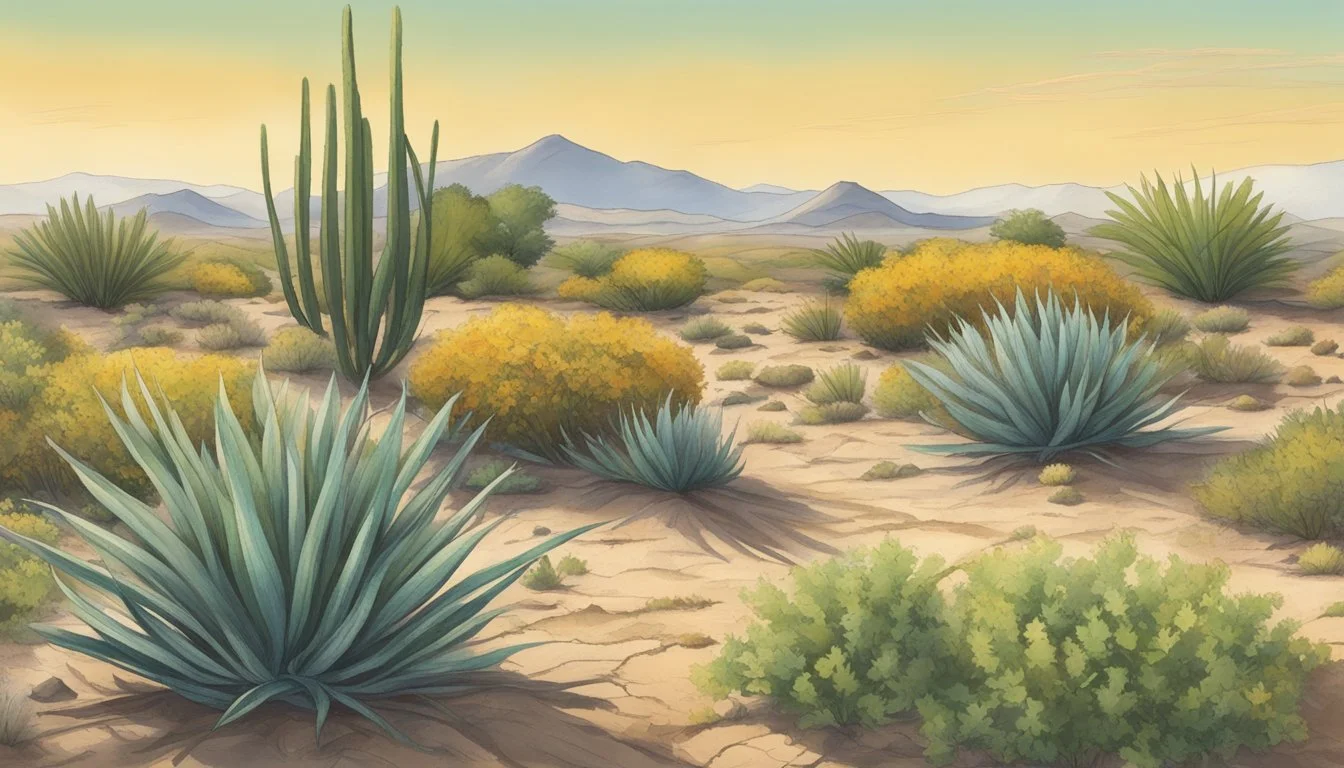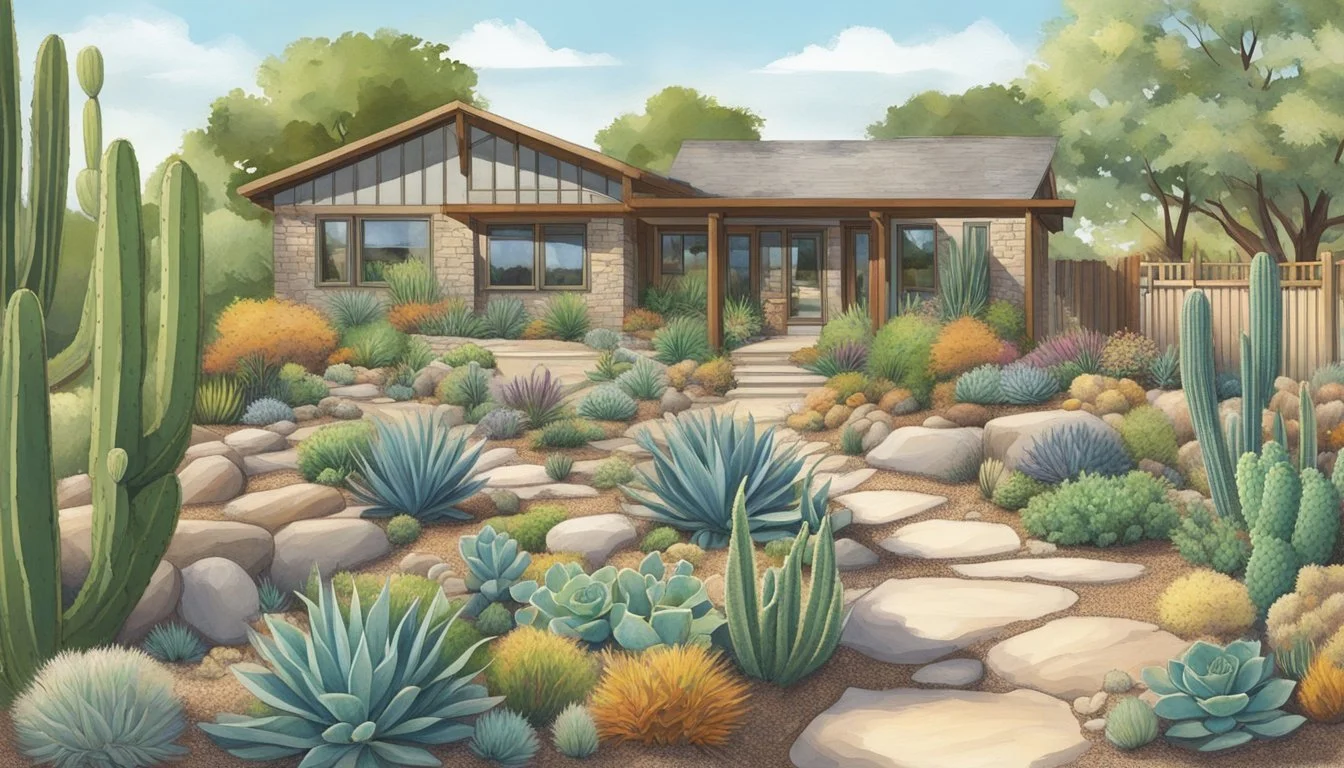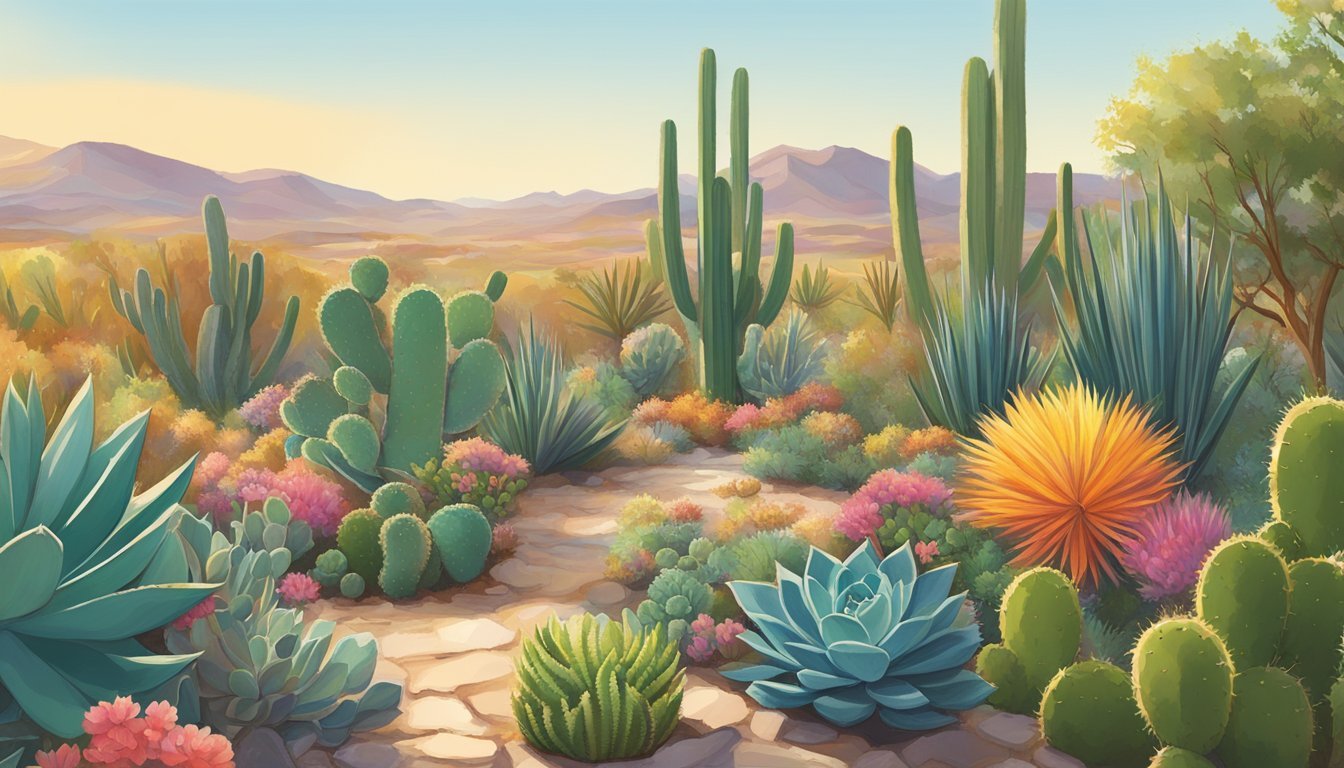Drought-Tolerant Plants in Kansas
Thriving in a Dry Climate
Drought-tolerant plants have become increasingly important in Kansas as the climate poses challenges for traditional landscaping and agriculture. The state, characterized by its varying weather patterns, has been experiencing drier seasons, making water conservation a critical aspect of garden design. Gardeners and farmers alike are turning to plants that can thrive with minimal water, ensuring sustainability and resilience in the face of prolonged dry spells.
Selecting the right plants for a Kansas garden means considering species that are not only tolerant of drought conditions but also compatible with the local climate and soil types. Drought-tolerant ornamentals, for example, offer an aesthetic appeal while requiring less water than their thirstier counterparts. Native plants are particularly well-suited to the region's conditions, often requiring less maintenance and offering the added benefit of supporting local wildlife.
Incorporating drought-tolerant plants into Kansas landscapes not only conserves water but also promotes a healthier ecosystem. By choosing the appropriate species, gardeners can create lush, vibrant gardens that withstand the fluctuations of Kansas weather, contributing positively to the environment while enjoying the range of textures and colors these plants provide.
Kansas Climate and Drought Conditions
Kansas, situated in the heartland of the United States, endures a range of weather extremes that significantly affect its agriculture and natural resources. Understanding Kansas climate zones and the state's history of drought is crucial for adapting to these environmental challenges.
Understanding Kansas Climate Zones
Kansas's climate is primarily continental, with cold winters and hot, often humid summers. The state experiences three distinct climate zones: the humid eastern segment, the semiarid central region, and the arid western plains. Various factors including elevation and prevailing winds influence the different weather conditions across these zones, with rainfall diminishing considerably from east to west.
History of Drought in Kansas
Drought is a recurrent concern in Kansas, with a history of impactful dry spells. According to Drought-Tolerant Plants for a Challenging Kansas Climate, the state has faced periods where water conservation has been critical. Historical data points to droughts that have not only curtailed agricultural production but also triggered wider ecological repercussions.
Tracking drought conditions through resources such as the U.S. Drought Monitor allows for timely responses to emerging dry spells, underscoring the importance of understanding and preparing for these natural events. The frequency and severity of drought are anticipated to fluctuate, reflecting broader climatic patterns influencing Kansas's distinct climate zones.
The Importance of Drought-Tolerant Plants
As climate challenges intensify, especially in regions like Kansas, the employment of drought-tolerant plants becomes critical for water conservation and supporting local ecosystems.
Water Conservation Benefits
Drought-tolerant plants, especially those native to Kansas, significantly reduce the need for watering. Water conservation means using less of the valuable resource to maintain landscapes. Increased reliance on plants that require minimal watering better aligns with the natural climate and preservation goals. An extensive list of low-water-use plants serves as a testament to the potential for diverse, vibrant gardens even in water-scarce conditions.
Supporting Local Ecosystems
Incorporating drought-tolerant plants benefits native Kansas pollinators. The inclusion of flora such as coneflowers or sunflowers serves both as habitat and food sources for local pollinators, which play a vital role in a healthy ecosystem. The selection of plants should prioritize those that co-evolved with Kansas's local fauna to reinforce and sustain the indigenous biological network, encouraging a balanced relationship between native plants and pollinators.
Plant Selection for Drought Conditions
Selecting the right plants for drought conditions is crucial for maintaining a resilient garden in Kansas' climate. Drought-tolerant species, especially those native to the region, can thrive with minimal watering and withstand the harsh prairie environment.
Native Plants and Their Advantages
Native plants in Kansas, such as the resilient Big Bluestem and Switchgrass, are pre-adapted to local weather patterns and soil types. These species are typically more drought-tolerant and require less water once established. They support local ecosystems, providing habitat and food for native wildlife.
Prairie Coneflower: Thrives in full sun and well-drained soils.
Butterfly Milkweed: Attracts pollinators and is suited to dry conditions.
The advantages of native plants include:
Lower Maintenance: They are already adapted to the local climate.
Ecosystem Support: They offer vital resources for native fauna.
For a list of drought-tolerant ornamentals, one can refer to resources such as Drought-Tolerant Plants for a Challenging Kansas Climate.
Adaptable Non-Native Species
While native plants are often recommended, certain non-native species can also adapt well to Kansas' drought conditions. These plants have been shown to handle reduced watering schedules and intense sun exposure.
Russian Sage: Offers a lavender-like fragrance and silvery foliage.
Sedum: Known for their succulent leaves and drought resistance.
These adaptable non-native species can add variety to the landscape while still maintaining water-wise principles. Nonetheless, care should be taken to avoid invasive species that might outcompete local flora.
Gardeners looking to create a drought-resistant landscape can visit the Kansas State University's Recommended Plants page for further guidance on suitable plant species.
Designing a Drought-Resistant Garden
When creating a garden that conserves water in Kansas, careful planning, plant selection, and soil management form the backbone of successful drought-resistant landscaping.
Planning and Layout Strategies
In the initial stages, it's essential to choose drought-tolerant plants well-suited for Kansas's climate, favoring native species for their resilience and lower water needs. Creating a xeriscape, which refers to a landscape that requires little to no irrigation, starts with grouping plants with similar water requirements, ensuring efficient water use. Incorporating a rain garden—a shallow depression that captures runoff—can take advantage of natural rainfall, reducing the need for supplemental watering.
Efficient irrigation is pivotal; drip irrigation systems target water directly to plant roots, minimizing waste. Designing garden paths and spaces with permeable materials also allows rainwater to filter into the soil rather than run off.
Soil Preparation and Mulching Techniques
The key to maintaining moisture and improving soil quality is the use of mulch. Organic mulches like wood chips or straw can retain soil moisture, regulate temperature, and reduce weed growth. The technique of mulching involves:
Applying a 2-3 inch layer of mulch around plants, without piling it against the stems or trunks.
Choosing mulch that complements your garden's aesthetic while providing functional benefits.
Preparing soil with organic matter can enhance its ability to hold water. Mixing in compost will improve soil structure and fertility, providing a better foundation for drought-tolerant vegetation to thrive. Aim for well-draining soil to prevent waterlogging and root rot in arid conditions.
Types of Drought-Resistant Plants
In Kansas, where water conservation is crucial, selecting the right drought-resistant plants can be the key to a thriving garden. These plants have adapted to survive with minimal rainfall, making them ideal for the Kansas climate.
Shrubs and Bushes
Shrubs and bushes that withstand dry climates are essential for creating a low-maintenance landscape. Ninebark (Physocarpus opulifolius) is a native shrub that is highly resilient and can thrive in various soil types, including those that are dry. Sumac varieties, such as the smooth sumac (Rhus glabra), are also drought-tolerant and add vibrant fall color to the garden.
Ninebark (Physocarpus opulifolius): Adaptable to dry soils; peeling bark; clusters of white or pink flowers.
Sumac (_Rhus spp.): Tolerant of dry conditions; notable for red autumn foliage and persistent fruit clusters.
Perennial Flowers and Grasses
Perennial flowers and ornamental grasses that are drought-tolerant can reduce the need for water and maintenance. The coneflower (Echinacea spp.), especially the purple coneflower (Echinacea purpurea), is renowned for its hardiness and ability to handle dry spells. Additionally, native grasses like switchgrass (Panicum virgatum) provide texture and movement in the garden, and they require very little water once established.
Coneflower (Echinacea purpurea): Needs minimal water; attracts pollinators.
Switchgrass (Panicum virgatum): Deep roots; tolerates poor, dry soils; provides winter interest.
Drought-Tolerant Trees and Evergreens
Trees and evergreens are vital for structure and year-round interest in drought-prone areas. The bald cypress (Taxodium distichum), although it thrives in wet conditions, surprisingly tolerates dry soils well when mature. Evergreens like juniper can also withstand dry conditions and provide greenery throughout the year.
Bald Cypress (Taxodium distichum): Adaptable to dry conditions; feathery foliage; distinctive bark.
Juniper (_Juniperus spp.): Requires minimal water once established; various forms and sizes available.
When choosing drought-tolerant plants for a Kansas garden, these shrubs, flowers, grasses, trees, and evergreens offer both resilience and beauty with minimal water requirements.
Drought-Tolerant Plant Care and Maintenance
Proper care and maintenance of drought-tolerant plants can enhance their survival in the challenging Kansas climate. Employing effective irrigation strategies, mulch use, and pest mitigation are key.
Irrigation Practices for Water-Wise Gardens
Drought-tolerant plants still require water, but it's crucial to apply it thoughtfully. The Kansas State Research and Extension recommends deep, infrequent watering to encourage strong root systems. One should irrigate early in the morning to reduce evaporation and ensure that the water reaches the roots rather than lingering on the foliage.
Mulch and Ground Cover Management
Using organic mulch can significantly conserve soil moisture and regulate temperature. For instance, a 2-3 inch layer of mulch around plants can reduce water needs and suppress weeds. Moreover, ground covers like Bermudagrass can serve as living mulch in lawns, protecting the soil from direct sunlight and reducing overall water usage.
Dealing with Pests and Disease
Even drought-tolerant plants can fall prey to pests and diseases in Kansan gardens. Regular inspection of plants for signs of stress such as wilting or discoloration can preempt outbreaks. One can often manage minor infestations with targeted treatments rather than resorting to wide-spread chemical applications, keeping the water-wise garden ecosystem intact and thriving.
Drought-Resistant Turf and Lawn Alternatives
In the heart of the United States, Kansas faces unique challenges when it comes to lawn care, pushing many to consider drought-resistant turf and lawn alternatives. These solutions are not only water-efficient but also cater to the aesthetic and ecological balance of Central Kansas landscapes.
Grass Species for Low Water Use
Kansas homeowners can opt for specific grasses that thrive with less water and still provide a lush, green lawn. Switchgrass (Panicum virgatum) is an ideal choice, known for its deep root system and ability to withstand dry spells. It serves dual purposes, both as an ornamental grass and a stabilizing force in preventing soil erosion.
Another grass that is particularly well-suited for Central Kansas's climate is Little Bluestem (Schizachyrium scoparium). This native prairie grass is not only drought-tolerant, but it's also deer-resistant, making it a practical option for more rural areas where wildlife interaction is common. A short profile of these grasses includes:
Switchgrass (Panicum virgatum)
Deep roots
Adaptive to varying soils
Supports local wildlife
Little Bluestem (Schizachyrium scoparium)
Low water requirement
Deer-resistant
Offers year-round visual interest
Ground Covers as Turf Substitutes
For those considering alternatives to traditional lawns, ground covers present a water-conserving and visually appealing solution. A popular option is Sedum, a low-maintenance ground cover that can flourish in the harsh summers and cold winters of Kansas. Its succulent leaves retain water, reducing the need for frequent irrigation.
Creeping Thyme is another ground cover alternative that endures drought conditions once established. It adds vibrant color and texture to the landscape and releases a pleasant aroma when walked upon. These ground covers are not only drought-tolerant but also attract beneficial insects and pollinators to the garden. In summary:
Sedum
Succulent, water-retaining leaves
Withstands extreme temperatures
Low maintenance
Creeping Thyme
Aromatic ground cover
Attracts pollinators
Dense mat inhibits weeds
Specialized Gardens and Landscaping
In Kansas, specialized gardens and landscaping techniques are vital in conserving water and sustaining plant life through challenging weather conditions. Two significant approaches include creating a xeriscape garden and engaging in wildflower and prairie restoration.
Creating a Xeriscape Garden
Xeriscaping is a landscaping method that reduces or eliminates the need for supplemental water from irrigation. It integrates drought-tolerant plants that are well-suited to the regional climate. These plants often require minimal watering, once established. According to resources like K-State Mesonet, the selection can include:
Drought-Tolerant Trees: Such as the resilient Honeylocust or the majestic Bur Oak.
Perennials and Shrubs: Including native species like Purple Coneflower and Leadplant.
Design elements that reduce water usage, such as mulching and strategic plant grouping, are key in xeriscaping. Homeowners who choose to xeriscape often save on water bills and maintenance while contributing positively to the environment.
Wildflower and Prairie Restoration
Wildflower and prairie restoration focus on reintroducing native plant species that once flourished in Kansas's prairies. These restoration efforts aim to establish ecosystems that are both aesthetic and functional, providing habitat for local wildlife and contributing to soil conservation.
Native Wildflowers include:
Butterfly Milkweed
Black-eyed Susan
Native grasses such as Big Bluestem and Switchgrass also play a crucial role in these environments. Entities like the Kansas Native Plant Society provide guidelines for species selection and management tailored to Kansas's landscape. Restoration of prairies requires understanding the soil types, sun exposure, and moisture levels unique to the locale to ensure a self-sustaining ecosystem.
Planting for Wildlife and Pollinators
In Kansas, selecting the right plants is crucial for creating a garden that supports both pollinators and wildlife. Utilizing drought-tolerant native plants ensures the survival of local species and promotes biodiversity.
Attracting and Supporting Pollinator Species
To support a diverse range of pollinator species, native wildflowers and fruit-bearing plants are ideal. They require minimal irrigation and offer an abundant source of nectar and pollen. For example, plants like the drought-tolerant allium offer appealing blooms for bees and butterflies while being resistant to common garden pests. Similarly, sagebrush provides both nesting materials for pollinators and food sources throughout the dry months.
Recommended Pollinators' Favorites:
Allium (Attracts bees and butterflies)
Sagebrush (Offers nesting materials and deters pests)
Dusty Miller (Attracts beneficial insects with its foliage)
Plant Choices for Bird and Wildlife Habitats
When choosing plants for bird and wildlife habitats, incorporating a mix of native ornamentals and wildflowers not only adds aesthetic value to gardens but also supports ecosystem health. Birds favor native fruit-bearing shrubs such as Serviceberry, which provide essential food and shelter. Ornamentals, which often bear fruits or seeds, serve as a food source and nesting grounds for birds and small mammals.
Bird-Friendly Plants:
Serviceberry (Provides food and shelter)
Native grasses (Offer seeds and cover)
Flowering perennials (Supply continuous blooms for food)
By focusing on these specific drought-tolerant native plants, Kansas gardeners can create sustainable and vibrant ecosystems that benefit both wildlife and pollinators.
Seasonal Care for Drought-Tolerant Gardens
When maintaining drought-tolerant gardens in Kansas, gardeners must take into consideration the region's distinct seasonal changes. Adapting gardening practices in spring, summer, and fall is crucial to the health and resilience of drought-tolerant plants, perennials, and native wildflowers.
Spring Planting and Preparation
In spring, the focus should be on preparing the soil and selecting plants that can survive dry conditions. Incorporating organic matter improves soil structure and water retention. It's advisable to choose drought-tolerant perennials and wildflowers that are acclimated to Kansas's climate. For example, planting drought-tolerant ornamentals can establish a resilient garden foundation.
Soil Preparation:
Amend soil with compost.
Ensure proper drainage.
Plant Selection:
Opt for native plants.
Introduce perennials that require minimal irrigation.
Managing Plants During Dry Summers
The summer heat can be intense, so managing moisture is key. Mulching is essential to conserve water, prevent weed growth, and keep roots cool. Watering should be done infrequently but deeply to encourage strong root systems. The Top 15 Drought-Tolerant Plants list provides excellent options that thrive in Kansas's summers.
Mulching:
Apply a 2–3 inch layer of organic mulch around plants.
Use mulch to reduce evaporation.
Watering:
Water early in the morning.
Utilize drip irrigation for efficient water use.
Fall Maintenance and Plant Protection
As autumn arrives, it's time to prepare plants for the cooler weather. Cutting back perennials, dividing them, and protecting them from cold with mulch can ensure their survival during winter. Planting fall wildflowers can also provide color and biodiversity to the garden.
Perennial Care:
Prune dead foliage.
Divide overcrowded plants for increased vigor.
Mulching for Protection:
Refresh mulch layers before frost.
Protect plants' root zones from freezing temperatures.
Popular Drought-Tolerant Plants for Kansas
In Kansas, where weather conditions challenge gardeners, certain plants thrive despite the dry climate. This selection of drought-tolerant plants is known for its resilience and ability to maintain beauty even when water is scarce.
Perennial Favorites
Coneflowers: These hardy perennials boast vibrant purple petals and a robust nature. They are well-suited to Kansas's climate, offering long-lasting blooms that attract pollinators.
Yarrow: Available in various colors, yarrow is appreciated for its feathery foliage and clusters of small, attractive flowers.
Daylilies: The hardiness and variety of daylilies make them a popular choice. Their trumpet-shaped flowers can bring a splash of color to any Kansas garden.
Catmint: Sporting a cloud of lavender-blue flowers, catmint is celebrated for its fragrant leaves and tolerance to dry spells.
Coreopsis: Often referred to as 'tickseed', coreopsis displays bright, cheerful flowers that can endure hot, dry summers with ease.
Russian Sage: With its silvery foliage and lavender flowers, Russian sage contributes a delicate, airy structure and can withstand drought conditions.
Shrubs and Ornamental Grasses
Shrubs and grasses that tolerate drought are essential for creating a landscape that conserves water yet remains visually appealing.
Junipers: These evergreens are known for their resilience and ability to cope with dry weather. They provide year-round structure and color to the garden.
Pinyon Pine: An evergreen tree that can act as a windbreak and provide habitat for wildlife, the pinyon pine is another drought-resistant option suitable for Kansas landscapes.
Buffalograss: As a native grass, buffalograss brings a natural and low-maintenance option for lawns, requiring less water than traditional turf grasses.
By incorporating these plants into their gardens, Kansas residents can enjoy a rich tapestry of color and form that stands up to the region's challenging climate.
Frequently Asked Questions
Selecting the right plants for the Kansas climate involves understanding the plant's water requirements and drought tolerance. This section answers common questions on the topic.
What are some low maintenance plants that can withstand drought in Kansas?
Low maintenance, drought-tolerant plants suited for the Kansas environment include species like the Purple Coneflower and Buffalo Grass. These plants are well-adapted to thrive in the state's often harsh, dry conditions.
Which native Kansas shrubs are known for their drought resistance?
Native Kansas shrubs such as the Fragrant Sumac and Leadplant are renowned for their ability to resist drought. These shrubs provide hardiness and beauty with minimal water.
Can you recommend any evergreen plants suited for dry Kansas conditions?
The Eastern Red Cedar is an evergreen that performs well in Kansas's dry conditions. It’s a hardy, versatile plant that provides year-round foliage.
What flowers are most likely to thrive in Kansas despite limited watering?
Flowers like the Black-Eyed Susan and the Missouri Primrose are likely to thrive in Kansas regardless of limited watering. These species are adapted to the local climate and soil conditions.
How can I identify the most drought-resistant plants for my garden in Kansas?
Identifying the most drought-resistant plants for a Kansas garden can be accomplished by consulting resources like the PDF Drought-Tolerant Plants for a Challenging Kansas Climate. Such guides offer comprehensive lists and planting tips.
What are the best practices for cultivating drought-tolerant landscaping in Kansas?
Best practices include selecting appropriate plants, like those listed in Recommended Trees and Shrubs, and implementing sustainable landscaping techniques such as mulching and efficient irrigation.








